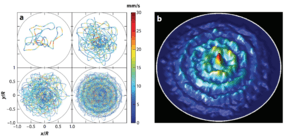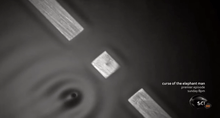Pilot wave
In theoretical physics, the pilot wave theory was the first known example of a hidden variable theory, presented by Louis de Broglie in 1927. Its more modern version, the de Broglie–Bohm theory, remains a non-mainstream attempt to interpret quantum mechanics as a deterministic theory, avoiding troublesome notions such as wave–particle duality, instantaneous wave function collapse and the paradox of Schrödinger's cat.
The de Broglie–Bohm pilot wave theory is one of several interpretations of quantum mechanics. It uses the same mathematics as other interpretations of quantum mechanics; consequently, it is also supported by the current experimental evidence to the same extent as the other interpretations.
History
In his 1926 paper,[3] Max Born suggested that the wave function of Schrödinger's wave equation represents the probability density of finding a particle.
From this idea, de Broglie developed the pilot wave theory, and worked out a function for the guiding wave.[4] Initially, de Broglie proposed a double solution approach, in which the quantum object consists of a physical wave (u-wave) in real space which has a spherical singular region that gives rise to particle-like behaviour; in this initial form of his theory he did not have to postulate the existence of a quantum particle.[5] He later formulated it as a theory in which a particle is accompanied by a pilot wave. He presented the pilot wave theory at the 1927 Solvay Conference.[6] However, Wolfgang Pauli raised an objection to it at the conference, saying that it did not deal properly with the case of inelastic scattering. De Broglie was not able to find a response to this objection, and he and Born abandoned the pilot-wave approach. Unlike David Bohm years later, de Broglie did not complete his theory to encompass the many-particle case.[5] The many-particle case shows mathematically that the energy dissipation in inelastic scattering could be distributed to the surrounding field structure by a so far unknown mechanism of the theory of hidden variables.
Later, in 1932, John von Neumann published a paper claiming to prove that all hidden variable theories were impossible.[7] (A result found to be flawed by Grete Hermann three years later, though this went unnoticed by the physics community for over fifty years). However, in 1952, David Bohm, dissatisfied with the prevailing orthodoxy, rediscovered de Broglie's pilot wave theory. Bohm developed pilot wave theory into what is now called the de Broglie–Bohm theory.[8][9]
The de Broglie–Bohm theory itself might have gone unnoticed by most physicists, if it had not been championed by John Bell, who also countered the objections to it. In 1987, John Bell[10] rediscovered Grete Hermann's work, and thus showed the physics community that Pauli's and von Neumann's objections really only showed that the pilot wave theory did not have locality.
Yves Couder and co-workers in 2010 discovered a macroscopic pilot wave system in the form of walking droplets. This system exhibits behaviour of a pilot wave, heretofore considered to be reserved to microscopic phenomena.[1]
The pilot wave theory
Principles

The pilot wave theory is a hidden variable theory. Consequently:
- the theory has realism (meaning that its concepts exist independently of the observer);
- the theory has determinism.
The positions and momenta of the particles are considered to be the hidden variables. However, the observer not only doesn't know the precise value of these variables, but more importantly, cannot know them precisely because any measurement disturbs them.
A collection of particles has an associated matter wave, which evolves according to the Schrödinger equation. Each particle follows a deterministic trajectory, which is guided by the wave function; collectively, the density of the particles conforms to the magnitude of the wave function. The wave function is not influenced by the particle and can exist also as an empty wave function.[12]
The theory brings to light nonlocality that is implicit in the non-relativistic formulation of quantum mechanics and uses it to satisfy Bell's theorem. Interestingly, these nonlocal effects are compatible with the no-communication theorem, which prevents use of them for faster-than-light communication, and so is empirically compatible with relativity.
Consequences
The pilot wave theory shows that it is possible to have a realistic and deterministic hidden variable theory, which reproduces the experimental results of ordinary quantum mechanics. The result however is nonlocality.
Mathematical foundations
To derive the de Broglie–Bohm pilot-wave for an electron, the quantum Lagrangian
where is the potential energy, is the velocity and is the potential associated with the quantum force (the particle being pushed by the wave function), is integrated along precisely one path (the one the electron actually follows). This leads to the following formula for the Bohm propagator:
This propagator allows to track the electron precisely over time under the influence of the quantum potential .
Derivation of the Schrödinger equation
Pilot Wave theory is based on Hamilton–Jacobi dynamics[13] rather than Lagrangian or Hamiltonian dynamics. Using the Hamilton–Jacobi equation
it is possible to derive the Schrödinger equation:
Consider a classical particle – the position of which is not known with certainty. We must deal with it statistically, so only the probability density is known. Probability must be conserved, i.e. for each . Therefore, it must satisfy the continuity equation
where is the velocity of the particle.
In the Hamilton–Jacobi formulation of classical mechanics, velocity is given by where is a solution of the Hamilton-Jacobi equation
and can be combined into a single complex equation by introducing the complex function , then the two equations are equivalent to
- with
The time dependent Schrödinger equation is obtained if we start with , the usual potential with an extra quantum potential . The quantum potential is the potential of the quantum force, which is proportional (in approximation) to the curvature of the amplitude of the wave function.
Mathematical formulation for a single particle
The matter wave of de Broglie is described by the time-dependent Schrödinger equation:
The complex wave function can be represented as:
By plugging this into the Schrödinger equation, one can derive two new equations for the real variables. The first is the continuity equation for the probability density: [8]
where the velocity field is defined by the guidance equation
According to pilot wave theory, the point particle and the matter wave are both real and distinct physical entities. ( Unlike standard quantum mechanics, where particles and waves are considered to be the same entities, connected by wave–particle duality. ) The pilot wave guides the motion of the point particles as described by the guidance equation.
Ordinary quantum mechanics and pilot wave theory are based on the same partial differential equation. The main difference is that in ordinary quantum mechanics, the Schrödinger equation is connected to reality by the Born postulate, which states that the probability density of the particle's position is given by . Pilot wave theory considers the guidance equation to be the fundamental law, and sees the Born rule as a derived concept.
The second equation is a modified Hamilton–Jacobi equation for the action :
where Q is the quantum potential defined by
By neglecting Q, our equation is reduced to the Hamilton–Jacobi equation of a classical point particle. ( Strictly speaking, this is only a semiclassical limit , because the superposition principle still holds and one needs a decoherence mechanism to get rid of it. Interaction with the environment can provide this mechanism.) So, the quantum potential is responsible for all the mysterious effects of quantum mechanics.
One can also combine the modified Hamilton–Jacobi equation with the guidance equation to derive a quasi-Newtonian equation of motion
where the hydrodynamic time derivative is defined as
Mathematical formulation for multiple particles
The Schrödinger equation for the many-body wave function is given by
The complex wave function can be represented as:
The pilot wave guides the motion of the particles. The guidance equation for the jth particle is:
The velocity of the jth particle explicitly depends on the positions of the other particles. This means that the theory is nonlocal.
Empty wave function
Lucien Hardy[14] and John Stewart Bell[12] have emphasized that in the de Broglie–Bohm picture of quantum mechanics there can exist empty waves, represented by wave functions propagating in space and time but not carrying energy or momentum,[15] and not associated with a particle. The same concept was called ghost waves (or "Gespensterfelder", ghost fields) by Albert Einstein.[15]
The empty wave function notion has been discussed controversially.[16][17][18] In contrast, the many-worlds interpretation of quantum mechanics does not call for empty wave functions.[12]
References
- 1 2 Couder, Y.; Boudaoud, A.; Protière, S.; Moukhtar, J.; Fort, E. (2010). "Walking droplets: a form of wave–particle duality at macroscopic level?" (PDF). Europhysics News. 41 (1): 14–18. Bibcode:2010ENews..41...14C. doi:10.1051/epn/2010101.
- ↑ "Yves Couder experiments explains Wave/Particle Duality via silicon droplets". How Does The Universe Work?. Through the Wormhole. 13 July 2011.
- ↑ Born, M. (1926). "Quantenmechanik der Stoßvorgänge". Zeitschrift für Physik. 38 (11–12): 803–827. Bibcode:1926ZPhy...38..803B. doi:10.1007/BF01397184.
- ↑ de Broglie, L. (1927). "La mécanique ondulatoire et la structure atomique de la matière et du rayonnement". Journal de Physique et le Radium. 8 (5): 225–241. Bibcode:1927JPhRa...8..225D. doi:10.1051/jphysrad:0192700805022500.
- 1 2 Dewdney, C.; Horton, G.; Lam, M. M.; Malik, Z.; Schmidt, M. (1992). "Wave–particle dualism and the interpretation of quantum mechanics". Foundations of Physics. 22 (10): 1217–1265. Bibcode:1992FoPh...22.1217D. doi:10.1007/BF01889712.
- ↑ Institut International de Physique Solvay (1928). Electrons et Photons: Rapports et Discussions du Cinquième Conseil de Physique tenu à Bruxelles du 24 au 29 Octobre 1927. Gauthier-Villars.
- ↑ von Neumann, J. (1932). Mathematische Grundlagen der Quantenmechanik. Springer.
- 1 2 Bohm, D. (1952). "A suggested Interpretation of the Quantum Theory in Terms of Hidden Variables, I". Physical Review. 85 (2): 166–179. Bibcode:1952PhRv...85..166B. doi:10.1103/PhysRev.85.166.
- ↑ Bohm, D. (1952). "A suggested Interpretation of the Quantum Theory in Terms of Hidden Variables, II". Physical Review. 85 (2): 180–193. Bibcode:1952PhRv...85..180B. doi:10.1103/PhysRev.85.180.
- ↑ Bell, J. S. (1987). Speakable and Unspeakable in Quantum Mechanics. Cambridge University Press. ISBN 978-0521334952.
- ↑ Harris, Daniel M.; Bush, John W. M. (2013). "The pilot-wave dynamics of walking droplets" (PDF). Physics of Fluids. 25: 091112. doi:10.1063/1.4820128. Retrieved 27 November 2016.
- 1 2 3 Bell, J. S. (1992). "Six possible worlds of quantum mechanics". Foundations of Physics. 22 (10): 1201–1215. Bibcode:1992FoPh...22.1201B. doi:10.1007/BF01889711.
- ↑ Towler, M. (10 February 2009). "De Broglie-Bohm pilot-wave theory and the foundations of quantum mechanics". University of Cambridge. Retrieved 2014-07-03.
- ↑ Hardy, L. (1992). "On the existence of empty waves in quantum theory". Physics Letters A. 167 (1): 11–16. Bibcode:1992PhLA..167...11H. doi:10.1016/0375-9601(92)90618-V.
- 1 2 Selleri, F.; Van der Merwe, A. (1990). Quantum paradoxes and physical reality. Kluwer Academic Publishers. pp. 85–86. ISBN 0-7923-0253-2.
- ↑ Zukowski, M. (1993). ""On the existence of empty waves in quantum theory": a comment". Physics Letters A. 175 (3–4): 257–258. Bibcode:1993PhLA..175..257Z. doi:10.1016/0375-9601(93)90837-P.
- ↑ Zeh, H. D. (1999). "Why Bohm's Quantum Theory?". Foundations of Physics Letters. 12: 197–200. arXiv:quant-ph/9812059
 . Bibcode:1999FoPhL..12..197Z. doi:10.1023/A:1021669308832.
. Bibcode:1999FoPhL..12..197Z. doi:10.1023/A:1021669308832. - ↑ Vaidman, L. (2005). "The Reality in Bohmian Quantum Mechanics or Can You Kill with an Empty Wave Bullet?". 35 (2): 299–312. arXiv:quant-ph/0312227
 . Bibcode:2005FoPh...35..299V. doi:10.1007/s10701-004-1945-2.
. Bibcode:2005FoPh...35..299V. doi:10.1007/s10701-004-1945-2.
See also
- Hydrodynamic quantum analogues
- Free-fall atomic model - modern search for electron trajectory
External links
- "Pilot-wave hydrodynamics" Bush, J.W.M, 2014, Annu. Rev. Fluid Mech., 49, 269–292.
- "Quantum mechanics writ large", Bush, J.W.M, 2010.
- "Pilot waves, Bohmian metaphysics, and the foundations of quantum mechanics", lecture course on pilot wave theory by Mike Towler, Cambridge University (2009).
- "Hydrodynamic quantum analogues" Research on hydrodynamic quantum analogues and hydrodynamic pilot-wave theory, by John Bush (MIT) and coworkers.
- More complete HTML encyclopedic page about the subject.
